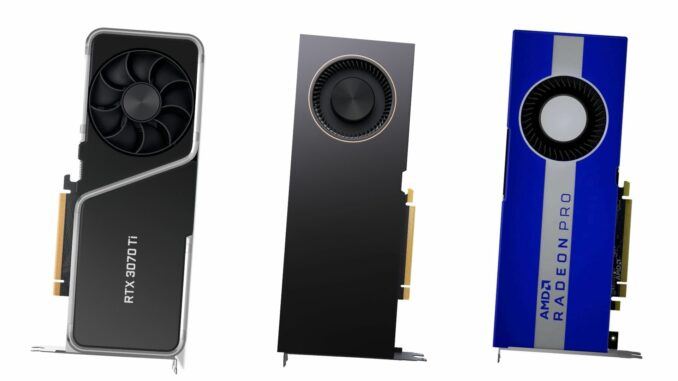
Please note: As an Amazon Associate I earn from qualifying purchases. I also work with other affiliate partners and may be compensated from the links below. Details here.
If your work involves creating visual effects and graphic design, or you work in the Animation and Industrial design industries, then you will agree that your workstation is the most important tool in your arsenal.
This becomes even more apparent when you delve into 3D rendering and modeling. Yes, I know a creative mind and great design skills are crucial, but with the right hardware, you can project what’s in your mind to your screen with pinpoint accuracy.
More specifically, you need the best graphics card for 3D rendering and modeling to get the best out of your designing software and boost productivity when working on complex designs that need high processing powers.
That’s why today, we will be taking a closer look at the 9 best graphics cards for 3D rendering and modeling in 2023, so you can choose the best GPU for your needs.
What to Consider When Buying a Graphics Card for 3D Rendering and Modeling
When buying a graphics card for creative work, the most important thing is to understand the most important specs, recognize your skill level and scope of work, and, therefore, don’t overpay.
Our guide will give you a better idea of what to look for and how to navigate the large number of options currently available to you on the market.
Nvidia vs. AMD
Nvidia and AMD are the two main graphics card manufacturers, and it can be hard to decide which of the two suits you best. AMD produces mid-level cost-efficient consumer GPUs that provide a balance between cost and power. AMD also makes professional-level GPUs under the Radeon PRO series.
Nvidia, on the other hand, is recognized in terms of performance and efficiency. Nvidia’s professional GPU series used to be called the Quadro, but as of 2021, they have dropped the Quadro name and are now the RTX A series graphics.
You may also come across GPUs from other vendors such as MSI, ASUS, EVGA, and Gigabyte. These are all GPUs made by either Nvidia or AMD. These vendors just take them and add customizations such as unique coolers, different I/O ports, and in some cases, higher clock speeds.
GPU Chip Architecture
This refers to the technology used to build the GPU. Nvidia and AMD develop new technologies about every two years, and each development comes with more advanced features and a better ability to utilize the available GPU resources.
For instance, an Nvidia card built using the Ampere architecture with 2000 cores will be more efficient than a graphics card with the same number of cores built with the less recent Turing architecture.
The Nvidia Ampere architecture is the most recognized when it comes to providing professional-level 3D modeling and rendering performance. For AMD, the RDNA and RDNA 2 architectures are what you should be looking for in your GPU.
VRAM
The GPU Video Memory (VRAM) should not be confused with the system RAM that is attached to your workstation’s motherboard. However, it functions the same way.
The VRAM is used to temporarily store data like textures, geometry, and shapes that you are using for 3D modeling and rendering so that they can be accessed easily and quickly.
The more VRAM a GPU has, the more data it can store and the more complex environments you can render.
Still, on memory, memory bandwidth is another important metric to look at when choosing the best graphics card for professional work. It’s a measure of how fast data is sent from the VRAM to the GPU and is calculated in Gigabits per second.
This will speed up the process of rendering tasks and will allow you to save time as a renderer. The amount of VRAM your card has can make the difference between a render taking an hour to complete versus ten minutes.
GPU Bus
The bus is the component used to connect the GPU to its machine, and its width determines how fast data is sent between the GPU and your system.
GPU Clock
This is also known as the core clock, and it’s a measure of how fast the GPU cores are. The faster the GPU clock speed, the faster the rendering process. Most cards will come with a base clock which is the speed at which card cores run normally, and a boost clock which is the maximum speed a card can reach when under heavy load.
Note that the GPU clock speed can only be used to compare graphic cards in the same generation. Using this metric to compare the performance of GPUs in different generations would be inaccurate because they run on a different architecture and often have different features that speed up or slow down rendering speeds.
And as we mentioned earlier, the card with the advanced architecture will have better utilization of the available resources and will often have specific features to assist in 3D rendering tasks. For instance, NVIDIA’s Ampere architecture will provide you with real-time ray tracing, DLSS, and artificial intelligence, which can all speed up your rendering workflow.
Number of cores
The more cores a graphics card has, the faster the rendering process. The GPU cores are also the components responsible for displaying shades in 3D objects and scenes, and therefore, you might hear them referred to as shaders.
Nvidia uses a custom programming language called CUDA for its cores, and it’s also the name given to the physical cores.
On the other hand, AMD cores are known as stream processors, and they run on the OpenCL programming language.
Again due to reasons we already mentioned, it would be inaccurate to compare the performance of graphic cards from different generations based on the number of cores.
Texture Mapping Unit (TMU)
This is the component that helps in applying textures to your 3D models. The more TMUs your graphics card has, the faster it fills your models with texture. This has wide usage in 3D rendering and modeling; for instance, if you are working in CAD or architectural design programs, you will want a GPU that can quickly and efficiently apply 3D textures to your prototypes and designs.
If you are working in a program like UnReal Engine, a high TMU count in your GPU will allow you to work on more graphically complex textures and make things like landscapes or faces appear more realistic to the viewer.
Render Operation Unit (ROP)
ROPs help to improve the accuracy of ray tracing and anti-aliasing. The Render Operation Units also help your GPU to display all the pixels during rendering regardless of the texture. The more ROPs that your card has, the better the rendering results.
Nvidia has the advantage here over AMD as the Ampere architecture has streamlined ROP. Real-time ray tracing from the RTX series has sped up the time needed to render ray tracing, creating better lighting effects and smoother transitions when compared to AMDs’ RDNA2.
Cost
After all is said and done, your budget is what will determine the graphics card you get for your 3D modeling and rendering workstation.
However, it is our hope that with all the information we have given, you will know when to stretch yourself a bit to get the best GPU for your workload.
Skip to:
Best Graphics Cards for 3D Rendering and Modeling for Professionals
Best Graphics Cards for 3D Rendering and Modeling for Advanced Users
Best Graphics Cards for 3D Rendering and Modeling for Beginners
Best Graphics Cards for 3D Rendering and Modeling Professionals
At this stage, you are a recognized 3D modeling and rendering expert with a workload of highly complex designs that need to be completed as soon as possible. You cannot afford to waste 3 hours rendering a model that could be finished in half the time.
Now it’s time to invest in the best of the best graphics card, and we have just the perfect solutions.
The table below will give you a quick look at our selections for the three best GPUs for 3D rendering and modeling professionals currently available on the market. To read a full review, simply click on ‘review>>’ in the respective row.
1. NVIDIA RTX A6000
”The Absolute Best GPU for Professionals”
CUDA Cores: 10752 | Base Clock: 1410 MHz | Boost Clock: 1800 MHz | Memory: 48 GB GDDR6 (ECC) | Memory Clock Speed: 16 Gbps | Memory Bus: 384-bit | TMUs: 336 | ROPs: 112 | Max. Monitors Supported: 4 | Power Consumption: 300 W | Dimensions: 10.5” x 4.4” (dual-slot)
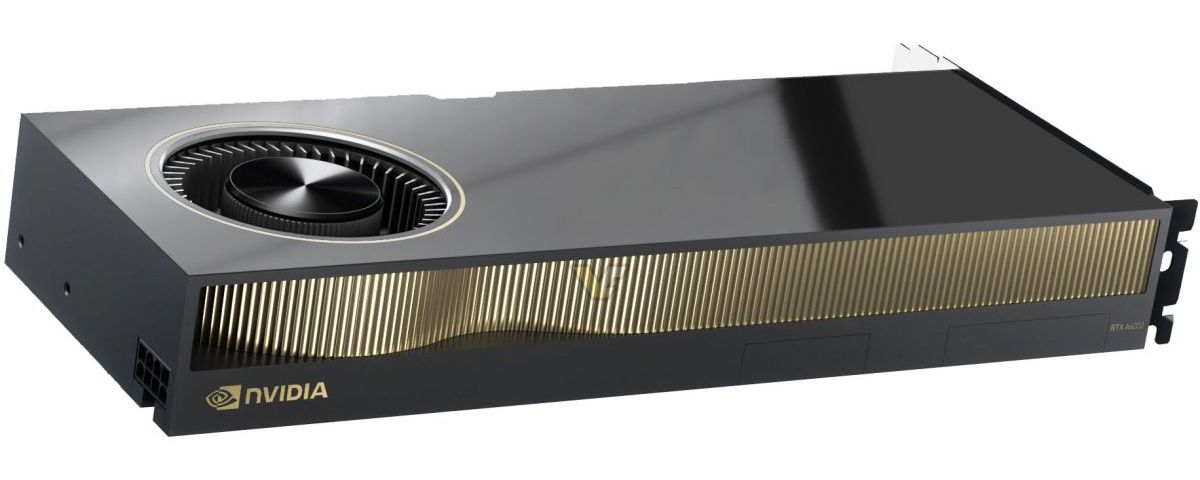
REASONS TO BUY
- By far the best GPU for creative professionals currently available
- Double the GPU rendering performance of Quadro RTX 8000 from the previous generation
- Near universal compatibility thanks to CUDA support in professional rendering applications
- 48GB VRAM for detailed and complex rendering projects (best VRAM on the market)
- 10,752 CUDA Cores for fast rendering and multitasking performance
- Excellent rendering speed
REASONS TO AVOID
- Expensive
- Comparable to the RTX 3090 in rendering speed
Our Rating: 9.9/10
The 2021 NVIDIA RTX A6000 still reigns supreme as the top-tier professional graphics card for 3D rendering and modeling professionals in 2023. NVIDIA has dropped the Quadro name for this card, but the performance gains associated with the Quadro branding have remained in the performance of the RTX A6000.
The A6000 from NVIDIA is aimed and designed directly for 3D rendering and modeling professionals and features a wide variety of professional certifications for rendering applications.
The big story with the new generation of NVIDIA professional cards like the A6000 is the integration of the NVIDIA Ampere Architecture, which streamlines multiprocessor functions and introduces second-generation Ray Tracing cores (RT Cores) to improve ray-tracing hardware acceleration, DLSS to improve performance in higher resolutions, and strongly increasing the CUDA cores to speed up rendering times and performance in 3D model development tasks.
The RTX A6000 has certified drivers for a wide range of professional applications, strong reliability, ECC memory, and a variety of specialized features specifically for professional-level visualization work. Shipping with 10,752 CUDA cores and 84 RT cores, this is a monster of a professional graphics rendering and modeling card that provides top-tier performance for real-time ray-tracing and fine frame ray-tracing output.
This is the fastest card we have seen at the time of writing, and we could not be more impressed with the power and performance of the RTX A6000.
This is currently the largest upgrade you could possibly buy for a professional editing, rendering, or 3D modeling workstation. With 48GB of GDDR6 VRAM, The A6000 can work with the largest 3D datasets, allowing creative professionals to create large 3D scenes without having to sacrifice complexity.
Additionally, the reliability features of the A6000 ensure that this card will keep your workstation running smoothly, even when editing the most complex datasets or renders.
In real-world testing environments, we saw the A6000 in Blender (OptiX) outperformed the Quadro RTX 8000 by a matter of 40 seconds in almost all categories except Koro. Supporting the PCIe 4.0 x16 interface,10,752 CUDA cores, and 84 RT cores, the A6000 shines as a professional powerhouse and is the most impressive professional-grade GPU we’ve seen so far.
We also noted the impressive 38.7 teraflops of single precision performance, making this the most powerful card we’ve tested for 3D rendering.
While this card’s overall performance is comparable to the consumer-focused RTX 3090 from NVIDIA, what truly sets this card apart is the niche features related to real-time ray-tracing and fine-frame ray-tracing output in editing programs.
Additionally, the professional application certifications of the RTX A6000 make this card incredibly reliable in a workstation computer, and when you are editing a complex movie or VR experience, the last thing you can afford is a GPU that’s crashing.
If you are pushing visual fidelity to its highest limits, the RTX A6000 from NVIDIA is your best bet currently. As the next generation of NVIDIA cards releases sometime in the future, the A6000 will still be an absolute powerhouse in rendering and design environments, ensuring you get longevity in exchange for a beefy price-point out of the A6000.
- YOU MAY ALSO LIKE: Best Graphics Cards Under $500
2. EVGA GeForce RTX 3090 FTW3 Ultra
”Best Value Card for Professionals”
CUDA Cores: 10496 | Base Clock: 1395 MHz | Boost Clock: 1800 MHz | Memory: 24 GB GDDR6X | Memory Clock Speed: 19.5 Gbps | Memory Bus: 384-bit | TMUs: 328 | ROPs: 112 | Max. Monitors Supported: 4 | Power Consumption: 350 W | Dimensions: 11.8” x 5.4” (triple-slot)
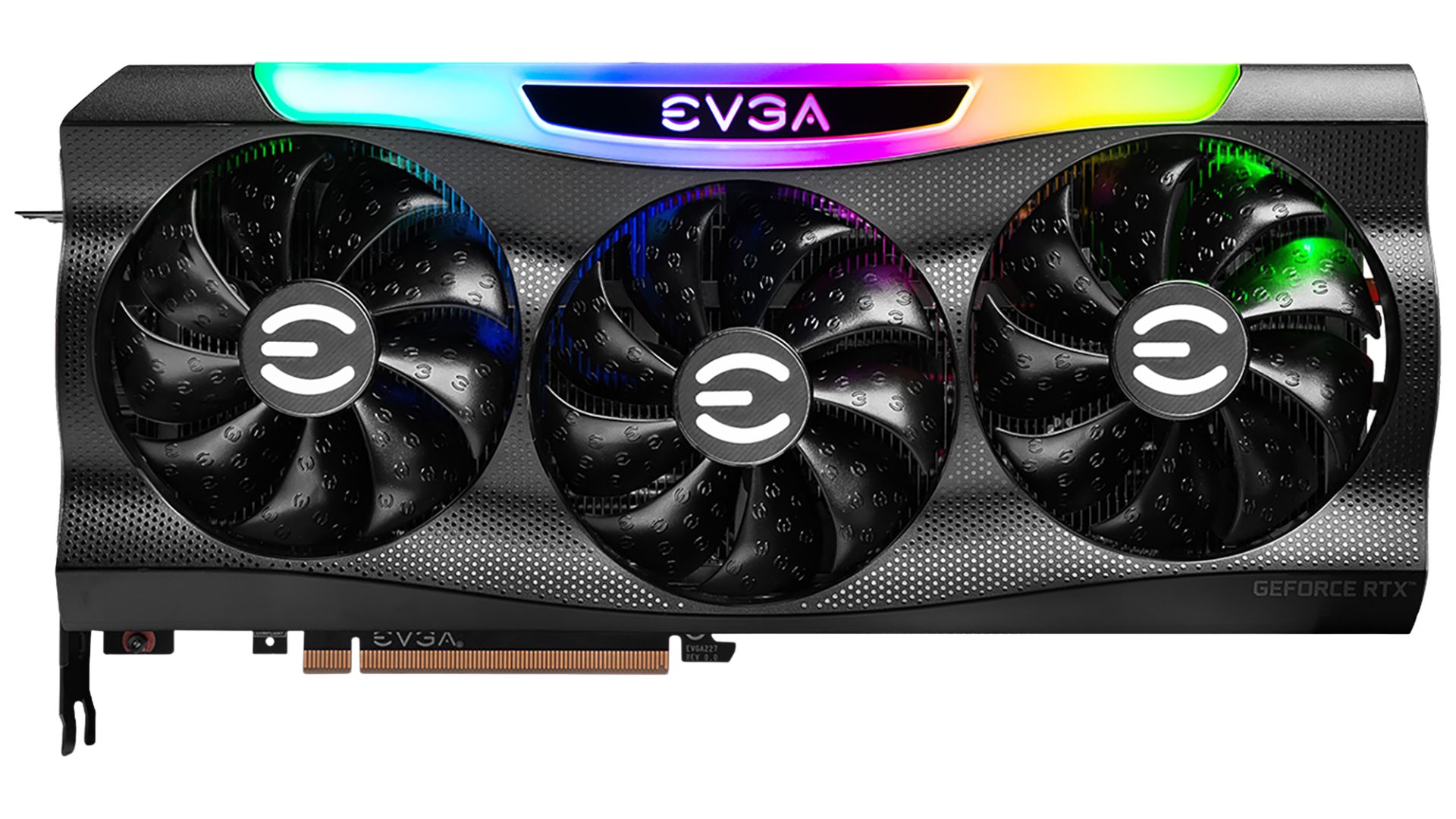
REASONS TO BUY
- Near universal compatibility in professional rendering applications thanks to CUDA support
- 10496 CUDA Cores for fast and efficient renders
- Significantly more affordable than the A6000 with similar rending speeds
- A massive amount of storage allows for highly detailed renders
- Quality construction
- Stays cool even under heavier loads
REASONS TO AVOID
- Non-ECC VRAM, lacks professional certifications
- Power-hungry
- Large
Our Rating: 9.8/10
The NVIDIA GeForce RTX 3090 is our favorite value card for 3D rendering and modeling professionals and provides some of the fastest rendering times on our list. While this card is directed at gamers and enthusiasts, it offers a comparable experience to the NVIDIA RTX A6000 in professional editing situations.
The NVIDIA GeForce RTX 3090 takes our top value spot because it features 10496 CUDA cores and 24GB of VRAM. The CUDA core count of 10,496 helps this card power through intensive workloads quickly and efficiently. Besides that, the RTX 3090 is one of the fastest possible cards on the market at the time of writing for 3D rendering while keeping a relatively low price when compared to the previous generation of professional cards such as the RTX Quadro, Titan, or the current-gen RTX A6000.
As with the A6000 in our list and the A4000, the 3090 also features the NVIDIA Ampere architecture, which provides an immense boost to 3D modeling and rendering workflows thanks to the increase in CUDA cores to speed up rendering times and performance in tasks related to 3D model development.
Benchmarking the RTX 3090, we found that in V-Ray Next Benchmark, the GeForce RTX 3090 24GB blew away all of the competition, scoring 782 Millions of Paths per Second (mpaths), compared to the GeForce RTX 3080 10GB scoring 638 mpaths. The RTX 3090 greatly reduces rendering time when compared to the RTX 3080 or previous generations of graphics cards.
If you work as a freelance 3D artist, then the RTX 3090 24GB is likely to save you a considerable amount of time on your projects and provide a good long-term return on investment when compared with the other cards on this list. However, the 3090 is by no means a budget or cheap card, and running multi-GPU setups based around the 3090 will grow very expensive, very fast.
The ability for the GeForce RTX 3090 to render quickly thanks to the 10,496 CUDA cores and handle 4K and 8K HDR video makes this the best-performing card on our list by a long shot, outperforming every other RTX card from NVIDIA and every AMD Radeon card.
Additionally, 24GB of VRAM will make quick work of your 3D modeling workloads while being powerful enough for generations to come, most likely. If you are working with large digital assets or rendering complex environments, the RTX 3090 is sure to make short work of your rendering workload while running cool, thanks to its blower-style fan model, which also allows you to efficiently run a multi-GPU setup in your workstation.
The most notable drawback of buying the RTX 3090 as a professional card for 3D rendering and modeling is the lack of ECC (error-correcting code) VRAM. ECC-VRAM detects and corrects errors that occur in the GPU’s memory chips and offers much more reliability compared to a standard non-ECC VRAM that the vast majority of gaming-oriented cards come equipped with.
All in all, the RTX 3090 provides a comparable experience to the RTX A6000 but comes at a much cheaper price point. The 3090, when compared to the A6000, is more power hungry and doesn’t have the same certifications and reliability for 3D rendering applications that you get the A6000. However, thanks to the Ampere architecture and the use of CUDA cores, the RTX 3090 will work with almost any rendering program with similar performance.
- RELATED ARTICLE: Best Graphics Cards Under $400
3. AMD Radeon Pro W6600
”Best Budget Graphics Card for Professionals”
Shading Units: 1792 | Base Clock: 2331 MHz | Boost Clock: 2580 MHz | Memory: 8GB GDDR6 | Memory Clock Speed: 14 Gbps | Memory Bus: 128-bit | TMUs: 112 | ROPs: 64 | Max. Monitors Supported: 4 | Power Consumption: 100 W | Dimensions: 9.5” x 4.4” (single-slot)
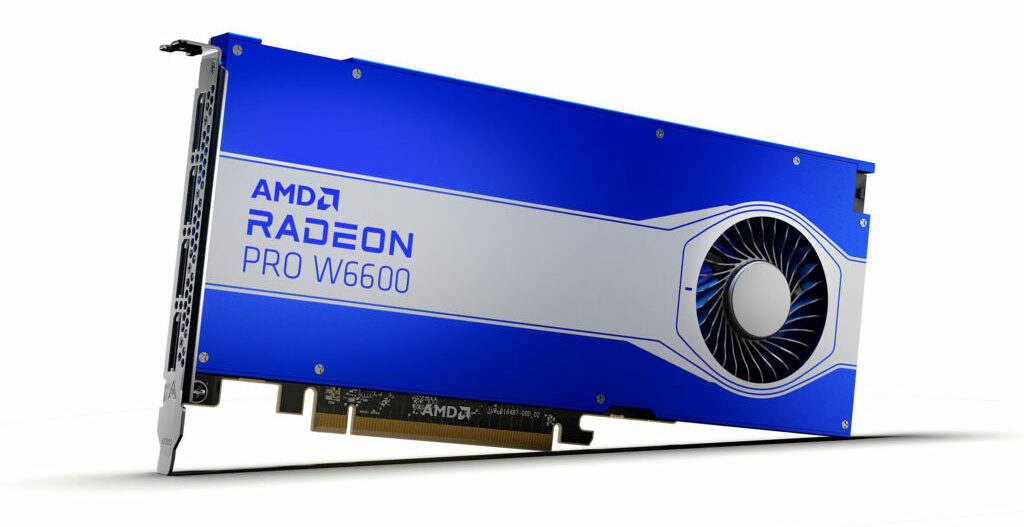
REASONS TO BUY
- Sub $800 price point
- Big improvement over the last generation of AMD professional cards
- AMD Ray Accelerator Technology speeds up rendering workflows
- Built-in Ray Tracing for great textures and lights in 3D modeling and rendering
- Certified AMD Rendering drivers with professional industry-standard compatibility for professionals
- Radeon Pro Render Support for Radeon-based professional rendering applications
- Compact, single-slot design
- Power-efficient
REASONS TO AVOID
- Only 8GB VRAM and less bandwidth allow for medium-resolution rendering details
- Less performance compared to Nvidia GPUs
Our Rating: 9.6/10
AMD has always been a mainstay in professional 3D rendering cards that are cost-efficient, and the AMD Radeon Pro W6600 is no different. For under $800, the AMD Radeon Pro W6600 is capable of handling 3D workloads and is a reliable card that isn’t too power-hungry when compared with the other professional-level cards on our list.
The Pro W6600 is the least powerful card on this list, shipping with only 8GB of VRAM, 10.4 teraflops of single precision performance, and 1792 cores, but it is also a certified professional workstation card that is found in the $500-700 price range, making it one of the most affordable current-gen 3D rendering cards on the market.
If your workstation isn’t updated with the most cutting-edge technology to handle cards like the RTX A6000 or the RTX 3090, the Pro W6600 is a great card for you. It’s certified for professional 3D rendering and visualization applications and handles 4K content with ease. Additionally, the W6600 features four DisplayPort 1.4 ports which is ideal for connecting your workstation to a multi-monitor setup when working on expansive rendering projects.
In real-world testing environments in which we tested the W6600 in Blender, we found the W6600 took 80 seconds to render in the BMW rendering test, falling below the majority of NVIDIA cards like the RTX 3080 Ti and RTX 3090. However, Blender had advantages over NVIDIA cards, and when we switched over to Radeon ProRender, the W6600 was on par with similar gaming cards (like the 6800 XT).
As comes with the territory of reviewing workstation GPUs like the W6600, there’s no single metric to measure cards against like we can with gaming cards. However, we did find a lot to like about the AMD Pro W6600, with its high performance in video encoding tests, Adobe Premiere Pro tests, and efficient performance in 3D blender and rendering testing software.
AMD’s RDNA2 has accelerated ray-tracing, but as of the time of writing, only Radeon ProRender supports RDNA2 ray-tracing. We found the W6600 handled daily rendering workflow well but, at times, could be slowed down when rendering complex 4K environments with a lot of individual details.
We particularly like the sub $800 value for this entry-level workstation card and found it to be the best possible deal for anyone looking for a current-gen, rendering application certified, professional workstation GPU to enhance their 3D rendering and modeling workflow.
We particularly appreciated the lower power draw of this card, coming in at only 100W TDP. This card is definitely aimed at freelance 3D renderers who may not be running the most updated rig, and if this sounds like you, we strongly suggest giving the AMD Radeon Pro W6600 a look.
Best Graphics Cards for 3D Rendering and Modeling for Advanced Users
At this stage, you are fully acquainted with 3D rendering and modeling. You can create complex models and need a significantly higher processing power to render your models efficiently. However, you are still not getting enough returns to invest in the highest-end GPU.
The table below will give you a quick look at our selections for the three best GPUs for advanced users currently available on the market. To read a full review, simply click on ‘review>>’ in the respective row.
1. NVIDIA RTX A4000
”The Absolute Best Graphics Card for Advanced Users”
CUDA Cores: 6144 | Base Clock: 735 MHz | Boost Clock: 1560 MHz | Memory: 16 GB GDDR6 | Memory Clock Speed: 14 Gbps | Memory Bus: 256-bit | TMUs: 192 | ROPs: 96 | Max. Monitors Supported: 4 | Power Consumption: 140 W | Dimensions: 9.5” x 4.4” (single-slot)
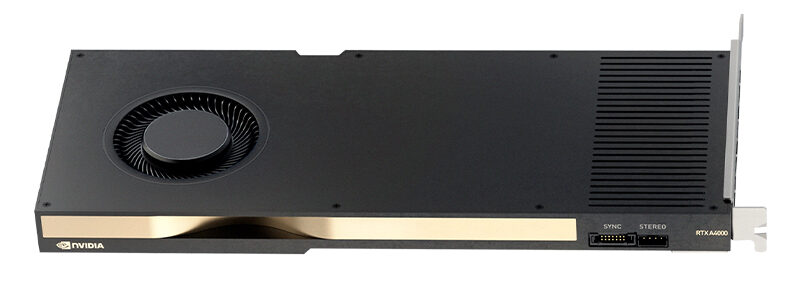
REASONS TO BUY
- Professional compatibility certifications for industry-standard rendering applications
- 6,144 CUDA Cores speed up rendering speeds and provide near-universal compatibility for rendering and modeling applications
- 16GB VRAM for medium to high-end rendering projects, allowing for high visual detail in renders
- One of the least power-hungry GPUs for advanced users at only 140W TDP
- Single-slot card makes it easy to set up multi-GPU configurations for intensive rendering projects
- Better performance per dollar when compared to the A5000
REASONS TO AVOID
- Comparable performance to cheaper consumer cards
Our Rating: 9.9/10
The RTX A4000 from NVIDIA features an impressive price-to-performance ratio and is geared toward advanced users and professionals looking to get the most power out of their GPU for 3D rendering and modeling workflows.
The A4000 sits behind the A6000 in performance gains, featuring 6,144 CUDA cores and 48 RT cores, and comes with 16GB of VRAM. Much like the A6000, though, the A4000 comes with the same professional 3D modeling, rendering, and video editing features, creative software application certifications, and NVIDIA’s own 3D rendering certified drivers.
As we mentioned earlier in our review of the A6000, the biggest upgrade to the current generation of professional NVIDIA cards was the jump to NVIDIA Ampere, which streamlines multiprocessing performance and introduces the second-generation of Ray Tracing cores all to improve 3D rendering performance with real-time ray tracing, DLSS for higher resolutions, and incredible rendering speeds in 3D model development tasks.
In our testing environments which incorporated real-world environments, we found the RTX A4000 to be on par with the more expensive RTX A5000 and far ahead of the last generation Quadro RTX 8000. In Blender, we tested with NVIDIA Optix; the A4000 still came out ahead in almost every test than the more expensive RTX A5000.
Testing in LuxMark, which tests 3D rendering in applications similar to UnReal Engine, we found the A4000 again maintained its speed with the A5000 and blew away the competition when compared with the previous generation of Quadro RTX cards. The only competition to this card was at the highest end of the professional series from NVIDIA, such as the RTX A6000, which also carries a premium high-end price tag.
When compared to the previous generation of Quadro RTX cards, the A4000 blew us away with its massive performance gains in every single possible benchmarking category. While NVIDIA has marketed this card to be the direct successor of the professional-level Quadro series, the A4000 brings a significant performance boost while retaining the professional compatibility certifications of the Quadro series cards.
For freelance and professional 3D artists, we found the A4000 to be the best-performing card in the professional class that doesn’t break the bank. While high-end professionals may value the A6000 more, the A4000 is the best overall card for advanced users. 16GB of VRAM will handle the majority of workloads, and at its competitive price, nothing came close in our testing environments to the A4000 without having to spend an extra thousand dollars.
Thanks to the expansion of NVIDIA’s Ampere Architecture, the A4000 will last for a few generation cycles as an extremely powerful and viable 3D rendering GPU. Ampere has been a huge leap forward in Ampere Architecture, and for under $1000, there is no better professional card than the A4000.
- YOU MAY ALSO LIKE: Best Low-power Graphics Cards Without External Power
2. NVIDIA GeForce RTX 3080 Ti
”Best Value Pick”
CUDA Cores: 10240 | Base Clock: 1365 MHz | Boost Clock: 1665 MHz | Memory: 12 GB GDDR6X | Memory Clock Speed: 19 Gbps | Memory Bus: 384-bit | TMUs: 320 | ROPs: 112 | Max. Monitors Supported: 4 | Power Consumption: 350 W | Dimensions: 11.2” x 4.4” (dual-slot)
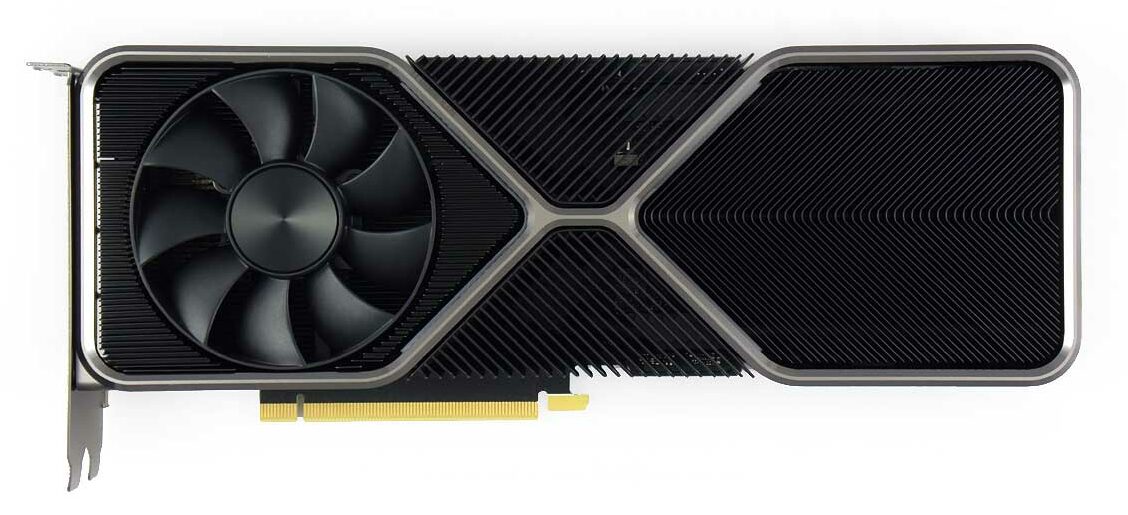
REASONS TO BUY
- Offers some of the fastest rendering speeds at its price point
- A large number of aftermarket options
- Wide-ranging compatibility thanks to CUDA support
- Fast VRAM clock speeds to enhance both rendering and gaming performance
- Comparable Performance to the 3090 at a better price point
- Affordable at under $1000
REASONS TO AVOID
- Power-hungry, needs a higher-powered PSU
- Lacks professional certifications and features
- Runs hot in multi-GPU setups
- Large and heavy
Our Rating: 9.7/10
While the RTX 3080-Ti makes a great card for gaming in 4K resolution, the card packs a pretty powerful performance when it comes to 3D rendering tasks and 3D modeling at a sub $1000 price point. This card is aimed at 3D professionals and gamers who are looking for a powerful GPU but don’t necessarily need the larger 24GB or 48GB VRAM that is found in the A6000 or RTX 3090.
In real-world testing environments, we found the 3080 Ti to pack a comparable punch to that of the RTX 3090, but for significantly less money. The 3080 Ti also managed to hold its own against professional-level 3D rendering cards like the NVIDIA RTX A4000 and AMD Pro W6600.
As noted earlier with the other current-gen NVIDIA cards in our list, the big boost to performance with the 3080 Ti comes from the NVIDIA Ampere Architecture. This boost streamlines multiprocessing performance and introduces the second generation of Ray Tracing cores, all to improve 3D rendering performance with real-time ray tracing, DLSS for higher resolutions, and incredible rendering speeds in 3D model development tasks. Additionally, Ampere gives the 3080 Ti a massive performance boost thanks to Artificial Intelligence.
Thanks to Ampere’s utilization of AI, processes that used to be slow manual tasks in 3D rendering are now automated and streamlined. The power of 10,240 CUDA cores makes rendering complex landscapes or VR features seamless, with rendering speeds in Blender and other testing environments as low as 25 seconds.
Real-time ray tracing is a breeze with the 3080 Ti, featuring 80 RT acceleration cores. The 3080 Ti efficiently handled high workloads, but we did notice some slowdowns from time to time, and the card can also run very hot. In some rendering tests, we noticed speeds of 60 degrees C, and the fan noise was quite noticeable even inside a workstation case.
If you play games to unwind from 3D modeling or to find inspiration for your next big project, the 3080 Ti can handle almost anything you throw at it in beautiful 4K resolution. One thing we noticed when doing some gaming with the 3080 Ti, however, is that it can, at times, run incredibly hot. Playing Metro Exodus in 4K, we noticed temperatures hovering around 75 degrees C.
As a value card for a freelance professional 3D renderer or a 3D renderer who also is looking to play games, the 3080 Ti delivers excellent performance at a price lower than the premium workstation graphics cards. If you don’t need the massive VRAM capacities featured in the workstation Pro graphics cards from AMD and NVIDIA, and you don’t mind the heat, the 3080 Ti is an ideal card to check out for your 3D rendering and visualization needs.
- READ ALSO: Best Graphics Cards for Streaming
3. NVIDIA GeForce RTX 3070 Ti
”Best Budget GPU for Advanced Users”
CUDA Cores: 6144 | Base Clock: 1575 MHz | Boost Clock: 1770 MHz | Memory: 8 GB GDDR6X | Memory Clock Speed: 19 Gbps | Memory Bus: 256-bit | TMUs: 192 | ROPs: 96 | Max. Monitors Supported: 4 | Power Consumption: 290 W | Dimensions: 10.5” x 4.4” (dual-slot)

REASONS TO BUY
- Affordable at under $700 price point
- Wide-ranging rendering program compatibility thanks to CUDA support
- Wide variety of aftermarket cards
- Power-efficient performance, will be compatible with lower-wattage power supplies
- Typically no issues with overheating
- Handles 4K performance well in both games and in rendering and modeling applications
REASONS TO AVOID
- Lacks professional certifications and features
- Large, dual-slot card
Our Rating: 9.6/10
We can’t get enough of the performance boost from Ampere in 3D rendering workflows, and for under $700, we can’t recommend a better card than the RTX 3070 Ti if you’re looking for a budget card that will still get you through your visual workloads quickly.
The 3070 Ti offers amazing performance, and with a sub $700 price point, it is easily our favorite budget card for 3D rendering and modeling artists. It ships with an impressive 6,144 CUDA cores and 46 RT cores to make quick work of 3D rendering workloads thanks to the NVIDIA Ampere Architecture.
With AI features, real-time ray tracing, and DLSS support, the 3070 Ti will deliver higher performance than its AMD counterparts. Digital editing tasks and 3D rendering workflows occur quickly with this gaming card, and the card can handle both 4K editing and gaming with ease.
If you are working with rendering at home and don’t have the most powerful system, the 3070 Ti is the card for you. This card will still be able to efficiently handle rendering workflows and tasks but won’t be as fast as the higher-end and professional-level cards we discussed earlier.
The 3070 Ti offers 3D artists a solid card for rendering projects and also allows you to unwind by gaming or watching movies in 4K resolution with 60 fps after a long day.
With 8GB of GDDR6X VRAM, you won’t have to worry about not having enough space for complex textures being used in rendering tasks. This graphics card is capable of 4K resolution, although it shines at 1440P resolution. One thing to watch out for is that this card requires two PCIe slots, so if you have a smaller case or want to have a multi-GPU setup, you will need to ensure you have the clearance first.
The 3070 Ti includes three DisplayPort outputs and a single HDMI output, making this an ideal GPU for a multi-monitor setup, and the card featured one of the lower power draws on our list, coming in at only a 290W TDP. This is the ideal card if you are looking for an affordable but still high-performing NVIDIA GPU for 3D rendering and modeling work.
As we mentioned earlier, thanks to the Ampere Architecture, the 3070 Ti will remain a powerful card for rendering work in years to come, and thanks to the CUDA cores, this card will perform well in nearly any 3D rendering application.
Best Graphics Cards for 3D Rendering and Modeling for Beginners/Hobbyists
At this stage, you don’t want to spend too much on a graphics card because your performance needs are low or you are not sure 3D designs and modeling is something you will pursue in the long term. Still, you need a powerful GPU that won’t need immediate replacement as soon as things start becoming serious.
The table below will give you a quick look at our selections for the three best GPUs for beginners/hobbyists currently available on the market. To read a full review, simply click on ‘review>>’ in the respective row.
1. NVIDIA GeForce RTX 3060 Ti
”Best GPU for 3D Rendering and Modeling Hobbyist Overall”
CUDA Cores: 4864 | Base Clock: 1410 MHz | Boost Clock: 1665 MHz | Memory: 8 GB GDDR6 | Memory Clock Speed: 14 Gbps | Memory Bus: 256-bit | TMUs: 152 | ROPs: 80 | Max. Monitors Supported: 4 | Power Consumption: 200 W | Dimensions: 9.5” x 4.4” (dual-slot)
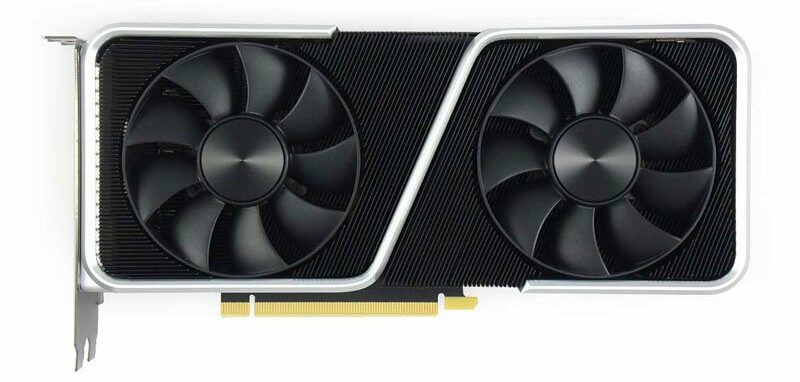
REASONS TO BUY
- Extremely affordable at sub $500 price point
- Wide-ranging rendering application compatibility for beginners
- Wide variety of aftermarket cards
- Quick rendering speeds in both creative applications and in games
- Low power draw, is compatible with entry-level builds and power supplies
- Great price-to-performance ratio
REASONS TO AVOID
- Slower performance from VRAM can delay rendering time
- dual-slot card
- Lacks professional certifications and features
Our Rating: 9.7/10
If you are learning 3D rendering and modeling, you will want a card that is compatible with the majority of rendering applications and a GPU that will last you for a while. Take a look at the 3060 Ti from NVIDIA.
This GPU is the entry-level card to NVIDIA’s Ampere architecture and features 8GB of GDDR6 VRAM and 4,864 CUDA cores to speed up rendering tasks. For under $500, we found the 3060 Ti to be the best overall price-to-performance ratio card for beginner or hobbyist 3D artists and visualization workers.
When benchmarking the 3060 Ti using OctaneBench and V-Ray, we found its performance incredibly impressive and just behind the performance benchmarks of the 3070. We saw the 3060 Ti falling behind the 3070 by an average of 5 to 8%, and for around $200 less than the 3070, we found this to be a really impressive card for beginners.
If you wanted a little extra speed in your rendering process and had the space in your build, you could easily install two 3060 Ti cards for efficient graphics processing power. The only thing to watch out for beforehand is that you have enough space in your case for airflow from the blower fans from the GPU.
While the 3060 Ti we tested was a dual fan GPU, the bulkier, triple fan 3060 Ti variants do produce a bit more heat, largely due to their heavier size, which can block airflow channels within your case, causing heat to be vented back into the system.
Thanks to the Ampere architecture, you get the same features designed for 3D rendering and modeling, like AI and DLSS, that you would receive in the higher-end 3000 series GPUs. These features both improve your efficiency and save you time when rendering 3D models.
It’s also worth noting that the 3060 Ti only has 8GB of VRAM available, so while most workloads in 3D rendering are easily handled, you won’t be able to render the most complex environments possible that you would with a GPU with 16GB or 24GB of VRAM.
If you are early on in your passion for 3D rendering and modeling, though, 8GB of VRAM will be more than enough for tutorials, practice renders, and home rendering projects. The extra AI features, real-time ray tracing, and DLSS will keep this card in your system until you need to upgrade for the purpose of VRAM to create more complex environments.
Overall, we strongly suggest the 3060 Ti as the best overall card for any new 3D artist who is maybe building their first system and doesn’t have the budget to spend thousands of dollars for a professional-grade 3D rendering workstation.
- RELATED READING: Best GPUs for 1440p 144hz Gaming
2. NVIDIA GeForce RTX 3050
”Best Value Pick”
CUDA Cores: 2560 | Base Clock: 1552 MHz | Boost Clock: 1777 MHz | Memory: 8 GB GDDR6 | Memory Clock Speed: 14 Gbps | Memory Bus: 128-bit | TMUs: 80 | ROPs: 32 | Max. Monitors Supported: 4 | Power Consumption: 130 W | Dimensions: 9.5” x 4.4” (dual-slot)
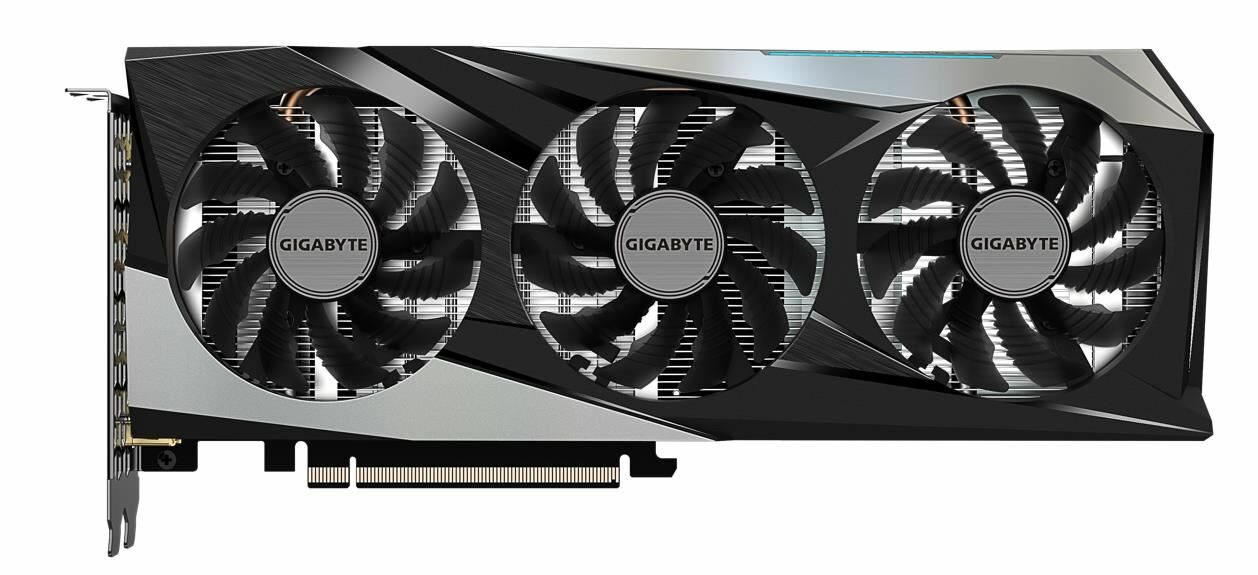
REASONS TO BUY
- Affordable at under $400 price point
- Good performance for a beginner 3D artist
- CUDA compatibility allows beginners to explore a wide range of rendering programs as well as speed up to workflows
- Low power draw, this GPU is compatible with entry-level systems
- New 3D rendering artists can experiment with ray-tracing
REASONS TO AVOID
- Slow Performance due to limited VRAM capacity and speed
- Not suitable for complex rendering projects
- No professional certifications and features
Our Rating: 9.5/10
It’s been no secret so far that NVIDIA has the upper hand in 3D rendering and modeling thanks to the use of CUDA cores which give NVIDIA GPUs wide compatibility with most rendering software available. The RTX 3050 is the cheapest of the RTX 3000 series cards and provides excellent value for any beginner or hobbyist 3D artist with its sub $300 price point.
If you are working on a brand new build and didn’t have a large budget for your other components but still want to get some work done in 3D rendering applications like V-Ray, Blender, or Maya, the 3050 will definitely get the job done, and you will get enhanced rendering performance thanks to the features included with the Ampere Architecture.
This is an ideal budget card for new 3D artists; its performance isn’t the best in rendering applications, but it’s by no means a terrible card, and for its price point, it’s a great bargain in terms of price-to-performance ratio.
The 3050 features ray tracing, the NVIDIA Ampere Architecture, 2560 CUDA cores, and 8GB of GDDR6 memory. While the CUDA core count is almost half of what’s featured in the 3060 Ti, the 3050 still performs pretty well in benchmarking rendering tests when compared with the 3060 Ti.
Overall, we found the RTX 3050 to, on average, run about 20-30 seconds behind the 3060 Ti, which for the low price point, made this our preferred value card for beginner 3D artists and renderers.
While the 3050 isn’t a great 3D rendering, the value it brings to a beginner 3D artist is hard to miss, thanks to all the great features packed in with the Ampere architecture. The 2560 CUDA cores, while half of what’s in the 3060 Ti, still provide speed and performance when rendering 3D models, and ray tracing technology will give you a performance boost to rendering physics and light.
Some things to watch out for with the 3050 are that, eventually, you will need to upgrade the card as your 3D workflows become more complex. If you are brand new to 3D rendering and don’t have a large budget to drop on an expensive GPU, though, this is a great choice to look at when comparing GPUs for rendering. CUDA accessibility and 8GB of VRAM will allow you to get a lot of beginners’ work and learning done, but the overall power of the card is lacking when compared to the higher-end AMD and NVIDIA cards.
This card does run slower than its counterparts, but at the low price point and the access to AI, DLSS, and real-time ray tracing make this our preferred budget card for 3D artists beginners.
- YOU MAY ALSO LIKE: Best Graphics Cards for 1080p 240hz Gaming
3. NVIDIA GeForce RTX 2060
”Best Budget GPU for 3D Rendering and Modeling Hobbyist”
CUDA Cores: 2176 | Base Clock: 1470 MHz | Boost Clock: 1650 MHz | Memory: 12 GB GDDR6 | Memory Clock Speed: 14 Gbps | Memory Bus: 192-bit | TMUs: 136 | ROPs: 48 | Max. Monitors Supported: 4 | Power Consumption: 184 W | Dimensions: 9” x 4.4” (dual-slot)
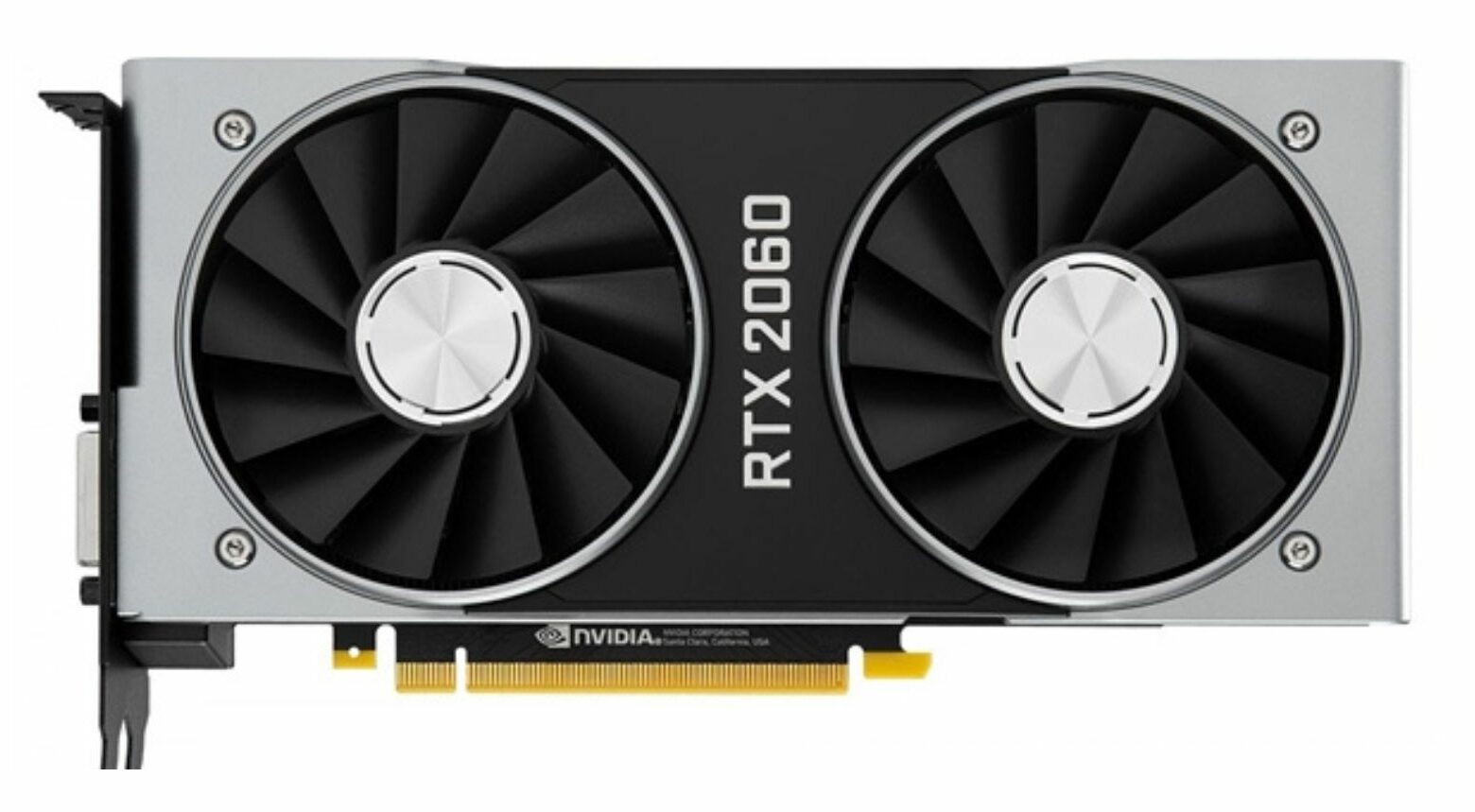
REASONS TO BUY
- Very affordable sub $300 price point
- Can fit into smaller PCs
- 12 GB of VRAM
- Great for college students who can’t build a full-tower system
- Great card for someone new to 3D rendering
- 1440P and 4K rendering performance in both rendering applications and games
- Power-efficient, this GPU is designed for entry-level systems
REASONS TO AVOID
- Slowest card on our list
- Less efficient than 3000-series GPUs
- No certifications or features of a professional card
Our Rating: 9.4/10
Thanks to the graphics card prices leveling off and previous-gen cards becoming less and less expensive, the RTX 2060 is our preferred pick for a budget-conscious beginner to 3D rendering and modeling. While it doesn’t pack the same punch as the 3000 series of cards, it still holds its own in rendering and is capable of 4K rendering performance. This is an ideal card for a student or someone new to 3D rendering who is on a really tight budget.
The RTX 2060 features real-time ray-tracing, which will greatly assist you in learning current-day 3D rendering techniques as well as make your workflow faster and make the process of learning 3D rendering less time-consuming and frustrating. This was one of the cheapest RTX 2000 cards, and it can be bought for a pretty low price tag, so if you are new to 3D rendering and building your first setup, we strongly suggest taking a look at the RTX 2060.
NVIDIA released the 2060 12GB version in 2021 as an attempt to help out the struggling GPU market deal shortages. The update to 12GB provides 3D renderers the ability to work with larger and more complex textures and environments while keeping a relatively low price tag.
Featuring 2176 CUDA cores, the 2060 12GB delivers real-time ray tracing and decent rendering speeds and doesn’t require the beefiest PC in the world to get the most out of this card. Entry-level 3D artists will appreciate the enhanced features from the RTX line but will be capped at the middle-ground of rendering projects and performance with only 2176 CUDA cores.
Compared to the 3050, the RTX 2060 provides a pretty similar performance, coming in only around 5-10% slower than the 3050. What’s most notable about this card, however, is that it does have a higher VRAM capacity than the 3050 and 3060 cards. This will allow beginner 3D artists to work on larger projects as part of their learning experience while still getting to experience the ray tracing bonuses from the RTX series.
Editing videos or working on animations also works well with the 2060 12GB thanks to its ability to handle 4K editing and decent speed. Overall, this card was not the best for gamers when it was released, but its VRAM capacity makes it a good deal for a beginner 3D render or artist, and if you do enjoy playing games, you will still get solid performance at 1080P and even 1440P depending on the other components of your system.
Why You Need The Best Graphics Card for 3D Rendering and Modeling
Various activities such as surface modeling, extrusions, lofts, sweeps, and shelling are complex and demand a lot of resources from your system. A GPU will take part of the workload from your CPU to facilitate a smoother experience.
Some modeling software allow you to work on your models in a realistic view instead of the basic wireframe and conceptual views. Having a powerful GPU will prevent your software from lagging during this process.
A great GPU will significantly reduce the amount of time it takes to render your models, especially the more complex ones. Unlike CPUs that feature few complex cores, GPUs come with hundreds or even thousands of specialized cores that split the rendering task between them.
It will facilitate smooth zooming and rotating. You have no idea how much toll these simple processes take on your system. And how many times will you perform the tasks on your models? Uncountable.
A great graphics card will also make the process of assembling models from separate components faster and effortless.
Gaming Graphic Cards Vs. Professional Graphic Cards
Games run highly optimized geometry to achieve maximum performance, which means they don’t push as many polygons through your graphics card as your 3D models do.
As a result, 3D modeling and rendering cards may need more VRAM, higher memory bandwidth, and more processing power than gaming cards.
This level of graphical computation can only be achieved by workstation graphic cards. These are also the best cards if you want something to aid in AI and scientific computation.
Pro Tip: Before purchasing a GPU, check the system requirements for the software you use for 3D modeling and rendering.
For instance, if you want to effectively render raw HD or 4K videos on adobe premiere pro, then you will require at least 2GB of GPU VRAM.
In Conclusion
There you go; these were the 9 best graphics cards for 3D rendering and modeling with various budgets and skill levels in mind. We really hope this article was helpful to you.
If we helped you to pick your next professional GPU, then make sure to share this with your friends on social media so we can help others, too.
Lastly, if you have any additional questions, feel free to comment down below, and we’ll be more than happy to help you out. We love hearing from you!










Be the first to comment